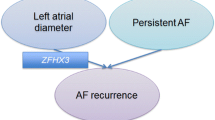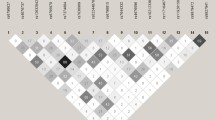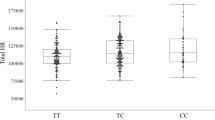Abstract
Receptor activator of nuclear factor-κB ligand (RANKL) had been confirmed contributing to the development and progression of AF by regulating atrial structural remodeling. But the involved genetic mechanism is unknown. We intended to explore the association between the polymorphism RANKL −1816C>G (rs7984870) and susceptibility and prognosis of lone AF. RANKL rs7984870 was genotyped in a case–control study of 828 patients and 834 controls in Chinese population. The CG and/or CC genotypes had an increased lone AF risk [adjusted odds ratio (OR) 1.20 for CG, OR 2.16 for CC, and OR 1.55 for CG/CC], compared with the GG genotype. Moreover, patients carrying CG/CC genotypes showed a higher possibility of AF recurrence after catheter ablation, compared with patients carrying GG genotype. In a genotype–phenotype correlation analysis using 24 normal left atrial appendage samples, increasing gradients of atrial RANKL expression levels positively correlated with atrial collagen volume fraction were identified in samples with CC, CG and GG genotypes. The in vitro luciferase assays also showed a higher luciferase activity of the −1816 C/C allele than that of the −1816 G/G allele. These results suggested that RANKL rs7984870 is involved in the etiology of lone AF and thus may be a marker for genetic susceptibility to lone AF and predicting prognosis after catheter ablation in Chinese populations. Therefore, we provide new information about treatment strategies and our understanding of RANKL in AF.


Similar content being viewed by others
References
Lau DH, Nattel S, Kalman JM, Sanders P (2017) Modifiable risk factors and atrial fibrillation. Circulation 136:583–596
Frustaci A, Chimenti C, Bellocci F, Morgante E, Russo MA, Maseri A (1997) Histological substrate of atrial biopsies in patients with lone atrial fibrillation. Circulation 96:1180–1184
Mujovic NM, Marinkovic MM, Potpara TS, Geller L (2015) Catheter ablation of lone atrial fibrillation. Curr Pharm Des 21:591–612
Cao H, Xue L, Xu X, Wu Y, Zhu J, Chen L, Chen D, Chen Y (2011) Heat shock proteins in stabilization of spontaneously restored sinus rhythm in permanent atrial fibrillation patients after mitral valve surgery. Cell Stress Chaperones 16:517–528
Cao H, Li Q, Li M, Od R, Wu Z, Zhou Q, Cao B, Chen B, Chen Y, Wang D (2013) Osteoprotegerin/RANK/RANKL axis and atrial remodeling in mitral valvular patients with atrial fibrillation. Int J Cardiol 166:702–708
Xi L, Cao H, Zhu J, Røe OD, Li M, Wu Y, Wang D, Chen Y (2013) OPG/RANK/RANKL axis in stabilization of spontaneously restored sinus rhythm in permanent atrial fibrillation patients after mitral valve surgery. Cardiology 124:18–24
Spierings DC, de Vries EG, Vellenga E, van den Heuvel FA, Koornstra JJ, Wesseling J, Hollema H, de Jong S (2004) Tissue distribution of the death ligand TRAIL and its receptors. J Histochem Cytochem 52:821–831
Cao H, Wang J, Xi L, Røe OD, Chen Y, Wang D (2011) Dysregulated atrial gene expression of osteoprotegerin/receptor activator of nuclear factor-κB (RANK)/RANK ligand axis in the development and progression of atrial fibrillation. Circ J 75:2781–2788
Ueland T, Yndestad A, Oie E, Florholmen G, Halvorsen B, Froland SS, Simonsen S, Christensen G, Gullestad L, Aukrust P (2005) Dysregulated osteoprotegerin/RANK ligand/RANK axis in clinical and experimental heart failure. Circulation 111:2461–2468
Hofbauer LC, Khosla S, Dunstan CR, Lacey DL, Boyle WJ, Riggs BL (2000) The roles of osteoprotegerin and osteoprotegerin ligand in the paracrine regulation of bone resorption. J Bone Miner Res 15:2–12
Tan W, Wu H, Zhao J, Derber LA, Lee DM, Shadick NA, Conn DL, Smith EA, Gersuk VH, Nepom GT, Moreland LW, Furst DE, Thompson SD, Jonas BL, Holers VM, Glass DN, Chen PP, Bridges SL Jr, Weinblatt ME, Paulus HE, Tsao BP (2010) A functional RANKL polymorphism associated with younger age at onset of rheumatoid arthritis. Arthritis Rheum 62:2864–2875
Moran CS, McCann M, Karan M, Norman P, Ketheesan N, Golledge J (2005) Association of osteoprotegerin with human abdominal aortic aneurysm progression. Circulation 111:3119–3125
Cao H, Wu Y, Li Q, Wu Y, Zhou Q, Røe OD, Chen Y, Wang R, Wang D (2014) Serum sRANKL/OPG predict recurrence after radiofrequency catheter ablation of lone atrial fibrillation. Int J Cardiol 170:298–302
Xu J, Cui G, Esmailian F, Plunkett M, Marelli D, Ardehali A, Odim J, Laks H, Sen L (2004) Atrial extracellular matrix remodeling and the maintenance of atrial fibrillation. Circulation 109:363–368
Spinale FG (2002) Matrix metalloproteinases: regulation and dysregulation in the failing heart. Circ Res 90:520–530
Yan AT, Yan RT, Spinale FG, Afzal R, Gunasinghe HR, Stroud RE, McKelvie RS, Liu PP (2008) Relationships between plasma levels of matrix metalloproteinases and neurohormonal profile in patients with heart failure. Eur J Heart Fail 10:125–128
Rhee EJ, Oh KW, Jung CH, Lee WY, Oh ES, Yun EJ, Baek KH, Kang MI, Kim SW (2006) The relationship between four single nucleotide polymorphisms in the promoter region of the osteoprotegerin gene and aortic calcification or coronary artery disease in Koreans. Clin Endocrinol (Oxf) 64:689–697
Sun T, Gao Y, Tan W, Ma S, Shi Y, Yao J, Guo Y, Yang M, Zhang X, Zhang Q, Zeng C, Lin D (2007) A six-nucleotide insertion-deletion polymorphism in the CASP8 promoter is associated with susceptibility to multiple cancers. Nat Genet 39:605–613
Acknowledgements
The authors thank Dr. Ruyang Zhang (Department of Biostatistics, Nanjing Medical University, Nanjing, China) for his statistical assistance.
Funding
This work was supported in part by Jiangsu Provincial Medical Youth Talent [QNRC2016034], Jiangsu Province Health Department Program Grant [Z201411], Key Project supported by Medical Science and technology development Foundation, Nanjing Department of Health [JQX14006 and YKK17066].
Author information
Authors and Affiliations
Corresponding author
Ethics declarations
Conflict of interest
The authors have no conflict of interest to disclose.
Rights and permissions
About this article
Cite this article
Cao, H., Xu, W., Chen, X. et al. Functional promoter −1816C>G variant of RANKL predicts risk and prognosis of lone atrial fibrillation. Heart Vessels 34, 151–158 (2019). https://doi.org/10.1007/s00380-018-1222-5
Received:
Accepted:
Published:
Issue Date:
DOI: https://doi.org/10.1007/s00380-018-1222-5




